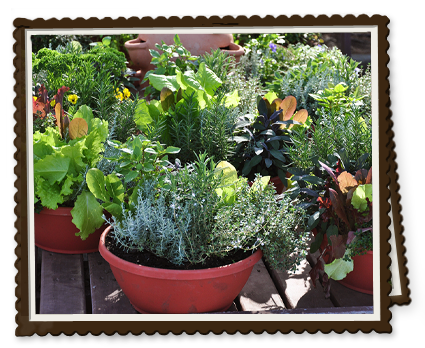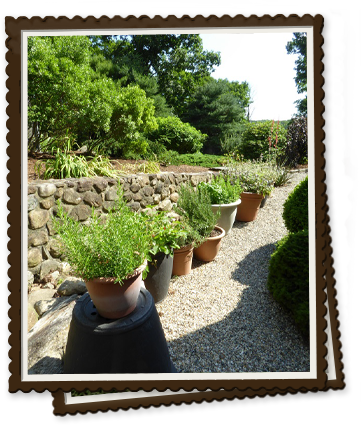
Seeds of Change
Container Gardening
Container Gardening 101
For those persons who like their gardens up close and personal, such as on their deck or patio, and for whom the thought of weeding is anathema - especially if you have to bend over - container gardening is the way to go. You can use large pots – square or round – or even plastic barrels. The larger the better, as they will retain moisture longer. Heavy duty plastic pots are easier to handle, also retain moisture better, and do not crack in the winter if they freeze when wet. Make sure you drill out the plastic drainage hole templates in the bottoms of your pots if not already done or you will drown your plants. You can put large pots on wheeled caddies so you can move them about as needed.
You can also get a variety of stationary, self-contained raised beds either made from coated, color-bond corrugated steel, or cedar wood beds on legs, usually in the 18”-24” wide x 2’-8’ long range. These containers stand 15” – 29” high, and some are “self-watering” which means they have a water reservoir and wick in the bottom (while this seems great, especially if you are away, I have found that in a rainy climate self-watering containers can unfortunately become water logged so I stay away from them.)
Your containers need to be filled with either Potting Soil or Container Mix, both of which are sterilized so they are weed-free. Potting soil actually has topsoil (actual dirt) in it along with a lot of organic matter (mostly peat moss.) It is generally nutrient rich and nutrient replenishable with liquid fertilizer, but in very large containers it can become too tightly packed which disrupts drainage. This leads to low aeration and poor root growth as containers generally do not sustain earthworms, Nature’s aerator. Container Mix, on the other hand, is light and fluffy, but has no real soil and is thus nutrient poor. It comes with fertilizer added, but unlike soil breaks down over time and needs to be replaced.
Gardeners Supply has a large selection of all sorts of pots, caddies, and self-contained raised beds. Potting Soil/Container Mix can be gotten at Lowes and Home Depot. Once you have purchased and filled your containers you are ready to decide what you want to plant!

The Kitchen Garden
You might consider the old tradition – and the convenience- of having a “kitchen garden.”
A Kitchen Garden is a small garden, near, of course the kitchen! And used to provide the immediate herbal seasonings that make all cooking yummy. (It was my German mother-in-law, Sigrid Benyei, who taught me to cook with herbs, as my own mother was more of a salt and pepper cook.)
Generally, herbs need a sunny spot, so strive to make your kitchen garden on the south or west side of the house if possible (east is also good, but north not-so-much.) Deer are generally not particularly fond of herbs, so this garden will not need varmint protection. In the photo we have made ours in Sunny South-side containers, as our kitchen is on the North side of the house. Here we have Fraises du Bois (woodland strawberries), sage, thyme, rosemary, oregano, and basil.
In your kitchen garden you can plant both annual and perennial herbs. Go-to perennials are chives which are sort of the onion without the bulb and are great in scrambled eggs; sage, which is super on chicken and pork; thyme (it comes in all sorts of varieties and has pretty, tiny, pink flowers) is also super on chicken, pea soup, and lots of other things; cilantro for all dishes Spanish; and perhaps some oregano for all things Italian. Lovage is also nice, but it gets really large and needs a lot of space. It has a celery-like flavor and looks like celery leaves. Mint – in either the peppermint or spearmint flavor - is also very nice for peas and ice tea. However, plant it in its own, very segregated patch, as it spreads by runners and will over-take everything! You can get most of these at Gilbertie's Herbs and Garden Center on Sylvan Rd, in Westport, CT.
Annual herbs that are particularly useful are parsley (curly or Italian) which is good in salads, a major part of tabbouleh, super on potatoes, and compliments most anything; sweet marjoram which is used in poultry dishes and soups; and rosemary (actually a tender perennial that you can winter inside), which is especially delicious on lamb, pork, and roasted potatoes. And don’t forget summer savory which is especially good on string beans, but also great in soups, stews, and lamb dishes.
All this stuff can be used fresh, or picked, hung up in a cool dark place and dried, and then stored in air-tight containers for winter use!
